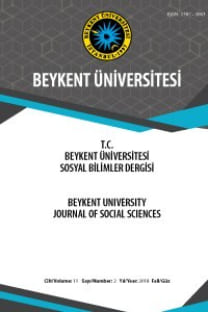ARCH VE GARCH MODELLERİ İLE REEL EFEKTİF DÖVİZ KURU TAHMİNİ ÜZERİNE BİR DEĞERLENDİRME: TÜRKİYE ÖRNEĞİ
İkinci Dünya Savaşı sonrasında ortaya çıkan küreselleşme, mikro ekonomik aktörlerin uluslararası ticaret ve finans sistemine entegrasyonunu artırmaktadır. Dolayısıyla döviz kurları ekonomik karar alma sürecinde önem kazanmaktadır. 1973 yılında Bretton Woods anlaşmasının sona ermesi, hükümetlerin esnek döviz kuru rejimini uygulamalarına neden olmuştur. Bu nedenle, yapısal sorunları olan ve yeterince gelişmemiş finansal sistemlerine sahip olan gelişmekte olan ülkeler için güvenilir döviz kuru tahmini önem arz etmektedir. Ayrıca, Covid-19 salgını sırasında güvenilir döviz kuru tahmini daha zor hale gelmiştir. Bu çalışma, ARCH ve GARCH modellerinin tahmin gücünü karşılaştırarak Covid-19 pandemisinde (2019M12-2021M08) reel efektif döviz tahminini araştırmayı amaçlamaktadır. Analiz bulguları, ARIMA(1,1,1) - ARCH(2) ve ARIMA(1,1,1) - GARCH(2,1) modellerinin az bir farka sahip olduğunu ve tahmin doğruluğu için en iyi modeller olduğunu göstermektedir. Elde edilen bulgulara göre politika yapıcılar ve mikroekonomik oyuncular, Covid-19 pandemisindeki reel efektif döviz kuru tahmininde ARIMA(1,1,1) - GARCH(2,1) modeline göre karar vermelidir.
Anahtar Kelimeler:
Reel Efektif Döviz Kuru Tahmini, ARCH Modellemesi, GARCH Modellemesi, Covid-19 Pandemisi
AN EVALUATION OF REAL EFFECTIVE EXCHANGE RATE FORECASTING WITH ARCH AND GARCH MODELS: THE CASE OF TURKEY
The globalization emerging in the post-World War II increases the integration of microeconomic economic players into the international trade and financial system. Hence, exchange rates gain importance for economic decision-making. The dismissal of the Bretton Woods agreement in 1973 caused governments to implement the flexible exchange rate regime. Therefore, reliable exchange rate forecasting has importance for developing countries having structural problems and underdeveloped financial systems. Moreover, reliable exchange rate forecasting is more complicated during the Covid-19 pandemic. This study aims at investigating the real effective exchange forecasting in the Covid-19 pandemic (2019M12-2021M08) by comparing the forecast power of ARCH and GARCH models. The analysis findings demonstrate that ARIMA(1,1,1) - ARCH(2) and ARIMA(1,1,1) - GARCH(2,1) models have a slight difference and are the best models for forecasting accuracy. According to the findings, the policy-makers and microeconomic players must decide on the ARIMA(1,1,1) - GARCH(2,1) model for real effective exchange rate forecasting during the Covid-19 pandemic.
___
- Aasim, S. N. Singh, & Mohapatra, A. (2019). Repeated wavelet transform based ARIMA model for very short-term wind speed forecasting. Renewable energy, 136, 758-768. Akgül, I., & Sayyan, H. (2008). Modelling and forecasting long memory in exchange rate volatility vs. stable and integrated GARCH models. Applied Financial Economics, 18(6), 463-483.
- Aloui, D. (2021). The COVID-19 pandemic haunting the transmission of the quantitative easing to the exchange rate. Finance Research Letters, 102025. https://doi.org/10.1016/j.frl.2021.102025.
- Aydın, D., & Güneri, Ö. İ. (2011). ÜFE ve TÜFE bazlı reel efektif döviz kuru endekslerinin parametrik olmayan regresyon teknikleri ile kestirimi. Finans Politik & Ekonomik Yorumlar, 48(553), 59-68.
- Ca'Zorzi, M., Kocięcki, A., & Rubaszek, M. (2015). Bayesian forecasting of real exchange rates with a Dornbusch prior. Economic Modelling, 46, 53-60.
- Çuhadar, M., Demirbaş, K., & Dayan, K. (2019). TÜFE Bazlı Reel Efektif Döviz Kurunun Alternatif Yaklaşımlarla Modellenmesi ve Tahminlenmesi. Süleyman Demirel Üniversitesi Sosyal Bilimler Enstitüsü Dergisi, (34), 78-103.
- Dickey, D. A., & Fuller, W. A. (1979). Distribution of the estimators for autoregressive time series with a unit root. Journal of the American statistical association, 74(366a), 427-431.
- Ediger, V. Ş., Akar, S., & Uğurlu, B. (2006). Forecasting production of fossil fuel sources in Turkey using a comparative regression and ARIMA model. Energy Policy, 34(18), 3836-3846.
- Enders, W. (2015). Applied econometric time series fourth edition.
- Engle, R. F. (1982). Autoregressive conditional heteroscedasticity with estimates of the variance of United Kingdom inflation. Econometrica: Journal of the econometric society, 987-1007.
- Esenyel, N. M., & Akın, M. (2017). Comparing Accuracy Performance of ELM, ARMA and ARMA-GARCH Model In Predicting Exchange Rate Return. Alphanumeric Journal, 5(1), 1-14.
- Gerlow, M. E., & Irwin, S. H. (1991). The performance of exchange rate forecasting models: an economic evaluation. Applied Economics, 23(1), 133-142.
- Lin, Z. (2018). Modelling and forecasting the stock market volatility of SSE Composite Index using GARCH models. Future Generation Computer Systems, 79, 960-972.
- Newaz, M. K. (2008). Comparing the performance of time series models for forecasting exchange rate. BRAC University Journal, 5(2), 55-65.
- Phillips, P. C., & Perron, P. (1988). Testing for a unit root in time series regression. Biometrika, 75(2), 335-346.
- Sağlam, M., & Başar, M. (2016). Döviz kuru oynaklığının öngörülmesi: Türkiye örneği. KMÜ Sosyal ve Ekonomik Araştırmalar Dergisi, 18 (31), 23-29.
- Taneja, K., Ahmad, S., Ahmad, K., & Attri, S. D. (2016). Time series analysis of aerosol optical depth over New Delhi using Box–Jenkins ARIMA modeling approach. Atmospheric Pollution Research, 7(4), 585–596.
- Uysal, D., & Özşahin, Ş. (2012). Reel efektif döviz kuru endeksi volatilitesinin ARCH ve GARCH modelleri ile tahmini. Anadolu Üniversitesi Sosyal Bilimler Dergisi, 12(1), 13-20.
- ISSN: 1307-5063
- Yayın Aralığı: Yılda 2 Sayı
- Başlangıç: 2007
- Yayıncı: Beykent Üniversitesi
Sayıdaki Diğer Makaleler
COVID-19 DÖNEMİ UZAKTAN ÇALIŞMANIN İŞ VE ÖZEL YAŞAMA YANSIMALARI ÜZERİNE BİR DEĞERLENDİRME
Zehra Nuray NİŞANCI, Aslı USTA
ÖRGÜTSEL SİNİZMİN ARDILLARI ÜZERİNE GÖRGÜL BİR ARAŞTIRMA
Seval AKSOY KÜRÜ, Oğuz DEMİREL
YEME BOZUKLUĞUNA İLİŞKİN KORKULAR ÖLÇEĞİNİN TÜRKÇE GEÇERLİK VE GÜVENİRLİK ÇALIŞMASI
Süleyman KAHRAMAN, Alara KERİMLER
Salih Zeki İMAMOĞLU, Serhat ERAT, Eda Dilara AYBER, Mustafa Zahid IŞIK
